
Fauna
Birds of Sweetwater Creek Nature Reserve
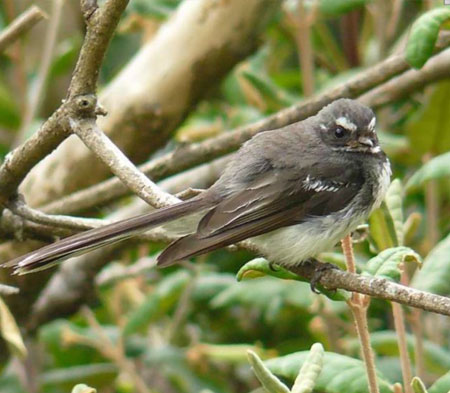
Grey Fantail
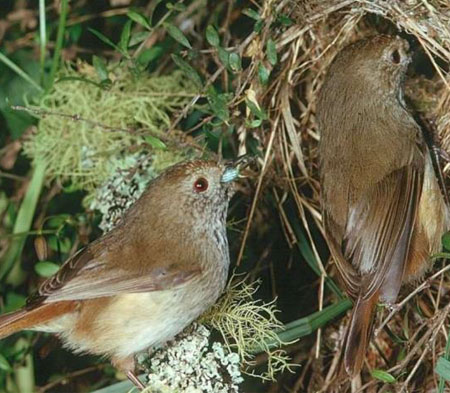
Thornbills
Both 10 cm. Almost the tiniest and most common birds in the reserve. They both have lovely markings and variations of colour as you can see here. They are busy little birds, always foraging for insects in the trees. Voice: Brown a soft churring or a short, sharp ‘tsip tsip’; Striated a sharper ‘tizz,tizz’.
Eastern Yellow Robin
a sociable visitor when we are weeding, hoping for worms or insects to surface. A running, piping call.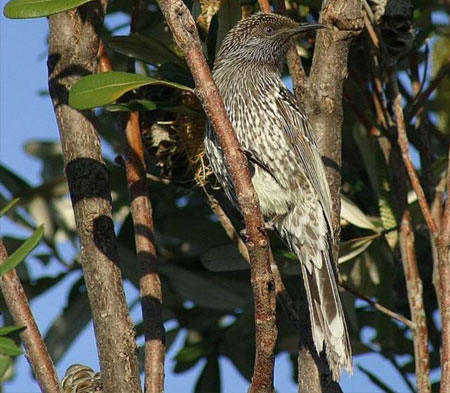
Little Wattlebird
27-33 cm. Smaller than the above, no red wattles. Voice: Similar call – more ‘kwock’ – and flight. Both birds love Banksias and Eucalypt flowers, and insects.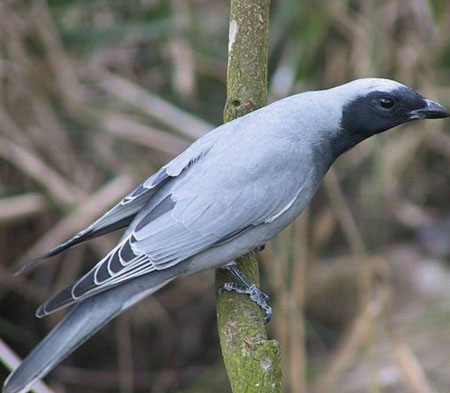
Black-faced Cuckoo Shrike
26-28 cm. Striking black face and throat, pale grey body with darker grey wing tips. Most recognisable by its swift direct flight with closed wings. Voice: Musical, churring or a sharp ‘skair!’ in aggression.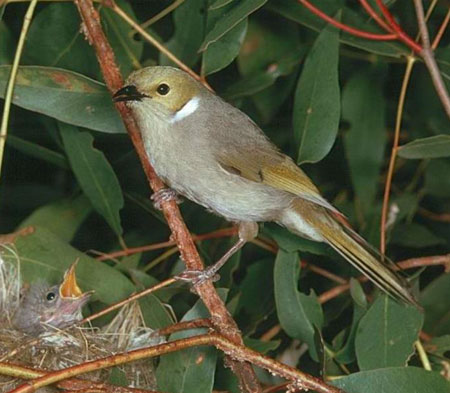
White-plumed Honeyeater
15-19 cm. Greenish yellow with a white plume below its cheek. More likely to be seen near water. Voice: ‘che-uck-oo-whee’ and a loud ’ti-ti-ti’ in alarm.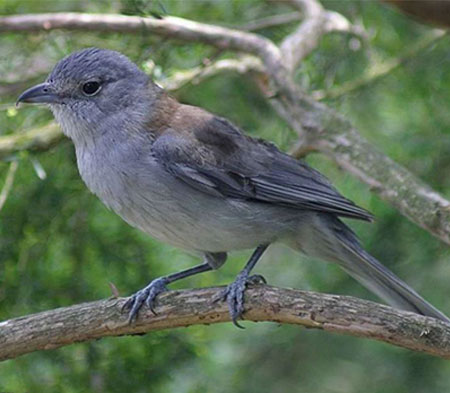
Grey Shrike Thrush
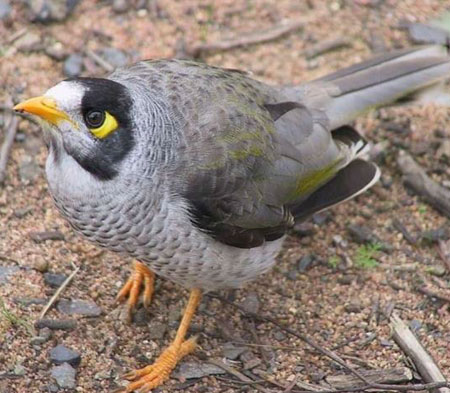
Noisy Miner
25-28 cm. Although an indigenous bird the Noisy Miner is regarded with disapproval for its aggressive behaviour towards other birds. It often gathers in flocks and drives away any competition. Voice: A loud ‘zwit’ and a series of ‘weet, weet, weet’ as it flies. It can be quite melodic too.
Grey Butcher Bird
smaller than a magpie but similar in appearance,with a dark grey head, dull grey back, white throat and greyish underparts. Voice:beautiful, vigorous flute- like melodic piping.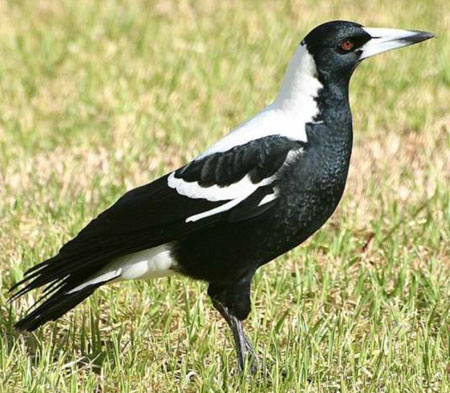
Australian Magpie
38-44 cm. One of the most familiar Australian birds. In spring they aggressively protect their nest sites by dive-bombing passers-by. Their raucous young constantly demand to be fed even as they reach the same size as their parents, and have mottled grey and white feathers which become the sharp black and white of the parents. Voice: A beautiful flute-like carolling, especially at dawn.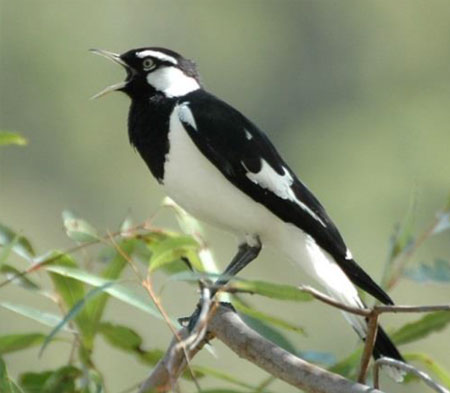
Magpie –Lark
26-30 cm. Also known as Mud-Lark as it builds its nest of mud. An elegant little bird as it struts confidently around, often with its mate. The male has a white eyebrow and a broader white patch below the eye than the female. Voice: A strident ‘pee wee’ (it’s other name) as well as a more melodic call.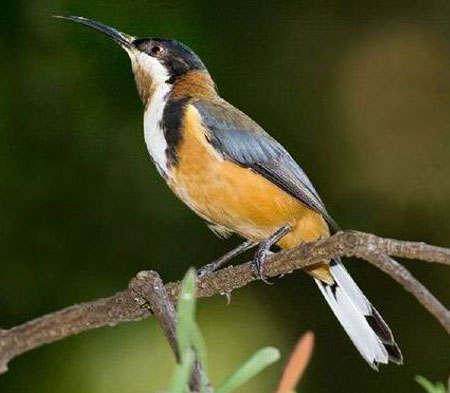
Eastern Spinebill
13-16 cm. An exquisite tiny bird with black and chestnut colouring that loves to probe correas and other tubular flowers for nectar. Voice: A running ‘pip pip pip’.
Common Bronzewing
Can be heard more often than seen,
a low booming call, repeated at three minute intervals.
Departs with a clatter of wings. Usually seen in pairs.
Named for the bronze sheen to its wings

Fan-tailed Cuckoo
blue-grey cuckoo with dull chestnut breast and yellow eye-ring.Voice a far-carrying mournful trill with downward inflection–ph-ph-phew, ph-ph-phew. More commonly heard in spring.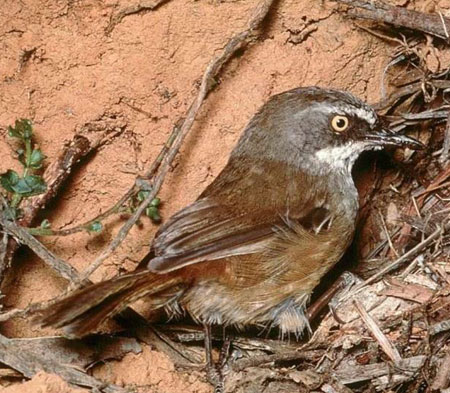
White-browed Scrub Wren
11-13 cm. Distinctive white eyebrows and throat. A busy hunter in the undergrowth. Voice: A scissory, sneezy ‘tseer,’tseer’ or ‘sit-you, sit-you’.
Eastern Rosella
White-cheeked rosella with red head and breast,yellow underparts, black and yellow mottled back, blue shoulders.Like the Rainbow Lorikeet, it nests in tree hollows. It eats fruit, nuts and seeds, often seen on lawns eating grass seed.Voice:a bell-like ‘pink, pink’ and soft chattering.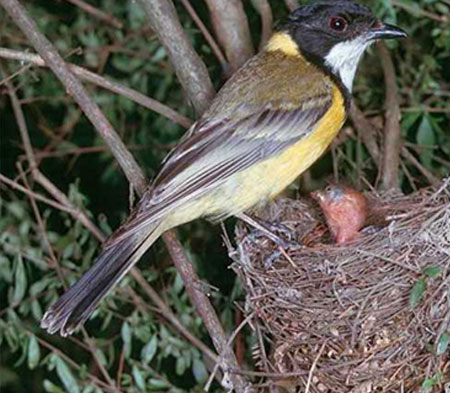
Golden Whistler
golden breasted with a white throat and black ‘hood’, olive back with yellow edges to wing feathers.Voice:This is the Luciano Pavarotti of the woodland,with a lovely melodic whistle.
New Holland Honeyeater
yellow and black wings and boldly -striped black and white breast, yellow and black tail feathers; slender curved black beak. Voice:a loud ‘tchlik’ and a whistling ‘pseet’, shrill harsh chattering.
Rainbow Lorikeet
Large blue-headed lorikeet with orange or red breast. Often seen at the entrance to a hole high in a tree trunk,where it makes its nest. They feed on eucalypt and Banksia blossoms often in noisy flocks.Voice:a noisy screech while in flight, noisy chatter while feeding.
Red-browed Finch
olive-backed with red ‘eyebrow’, grey underparts, red feathers at top of tail, then black. Commonly seen ina flock, often near water. Voice:high-pitched ‘pseet’.
Shining Bronze-Cuckoo
iridescent green bronze-cuckoo with bars on underparts extending to chin. Like the other cuckoos, heard but rarely seen.Voice:a series of whistles with an upward inflection, as if summoning ‘Here!
Here!’

Red Wattlebird
large wattlebird with yellow abdomen, small pendant red wattle below the ear; white tips on tail feathers. Swiftflight, catching insects in mid-air.Voice:noisy, ‘chock a lock’, like maniacal laughter!
Silvereye
Tiny olive green bird with grey chest and a distinct ‘silver’ ring around its eyes. They feed on insects, nectar and fruit and usually move rapidly in flocks.Voice:a loud ‘tsee’.
Spotted Pardalote
little bird,crown black with white spots, yellow throat and under tail. Digs a hole in an earth bank for a nest.Voice: high clear ‘sleep, peep’ rising to ‘deedee’.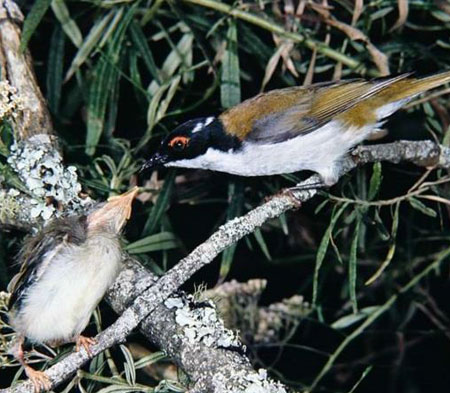
White-naped Honeyeater
13-15 cm. Small black-headed honeyeater with a white nape not meeting the eye, orange wattle over the eye, dull olive-green back, white chest. May move to Queensland in autumn. Voice: Soft ‘sherp, sherp’ or ‘tew, tew’.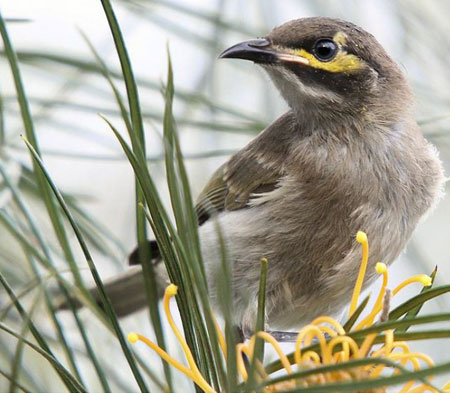
Yellow-faced Honeyeater
15-18 cm. A black mask split by a yellow stripe below the eye. Also migrates in autumn, returns July-October Voice: Loud cheery ‘chick-up’ and ‘pirrup, pirrup’.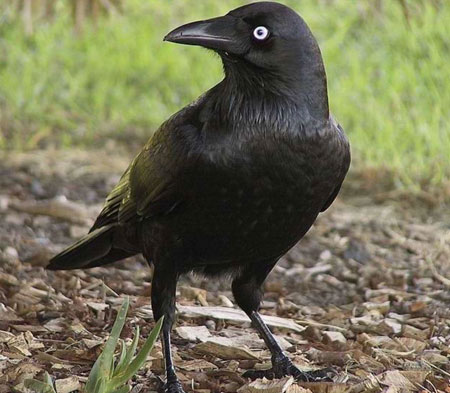
Little Raven
48-50 cm. Often called ‘crow’ but is an Australian bird. Its cry is not as loud or long as the bigger Australian Raven. Also more insectivore than scavenger than the latter. They roost communally and often fly in noisy groups.
Voice: Harsh, short, rapid ‘car car car’.
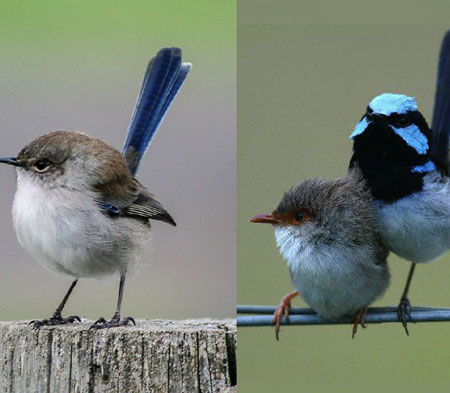
Superb Fairy Wren
14 cm Female and juvenile male both greyish with blue tails. Adult male has all the colour but moults to grey after breeding season. Not commonly seen, prefer low vegetation, last sighted on Liddesdale track. Voice: Short sharp ‘trrrt’.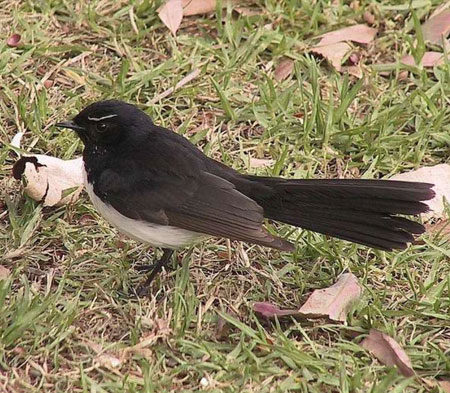
Willie Wagtail
19-22 cm. With its wagging fantail, cheeky white eyebrows and sharply defined black and white colouring the Willie Wagtail is a well-loved bird.
Voice: A ‘sweet pretty creature’ or a warning ‘rikka-tikka-tik’
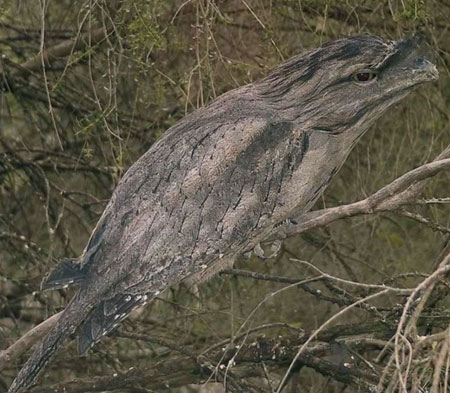
Tawny Frogmouth
32-46 cm. A master of camouflage by day, it is hard to see him against the grey bark of a tree branch where the flimsy nest will be in spring*. A nocturnal bird with a powerful frog-like beak, huge yellow eyes with a disconcerting stare if you should come face-to-face. We have some families in the reserve, but tree removal is a constant threat. Voice: A soft but penetrating ‘oom, oom’, usually heard in the early hours of the morning.Indigenous Animals
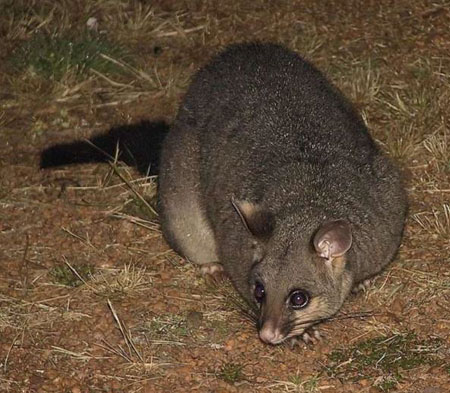
Common Brushtail Possum
The Brushtail is the biggest possum – 35-55 cm with a 25-40 cm tail and weighs 1.2-4.5 kg. It is the noisiest with its screams, hisses and growls. Babies born March –May, so all possums have young from autumn onwards into summer.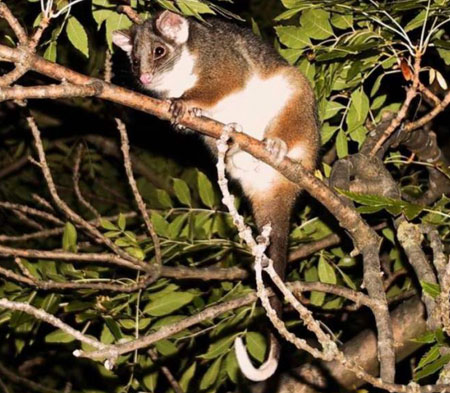
Common Ringtail Possum
The Ringtail is next in size – 30-35 cm plus the same length, prehensile, tail. Its call is a high-pitched ticking. Babies born April-December.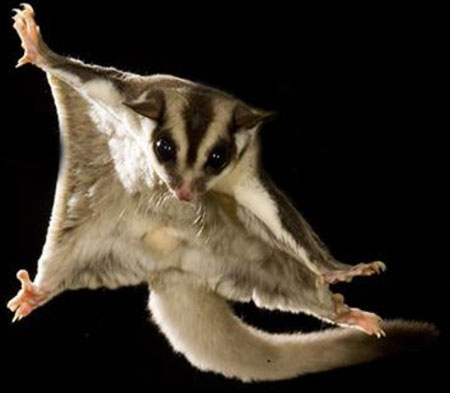
Sugar Glider
The Sugar Glider is the smallest with a 16-21 cm body and a tail the same length. It is named for its love of the sugar exuding from wattles which it accesses by chewing or scratching grooves in the bark and of course for its gliding method of moving from tree to tree. Its babies are born in June-January. It has a soft dog-like yapping call.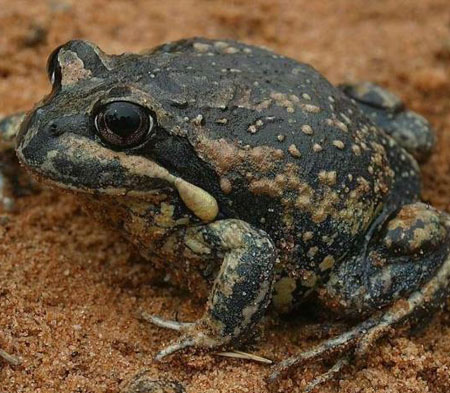
Southern Brown Bullfrog
70 mm. Large, thickset burrowing frog. Brown to grey brown with mottling on the back. Broad dark brown band behind the eyes to the flanks, raised pale brown stripe from beneath the eyes to the shoulders, underparts pale. Lays eggs August-January in pools and slow streams.
Voice: Often called the ‘Pobblebonk’ because of its plucking resonant call.
SWEETWATER CREEK NATURE RESERVE
- Australian Wood Duck
- Australian Raven
- Bell Miner
- Black Faced Cuckoo Shrike
- Brown Goshawk
- Brown Thornbill
- Brush Bronze Wing
- Eastern Rosella
- Eastern Shrike Tit
- Eastern Spinebill
- Fairy Wren
- Fantail Cuckoo
- Galah
- Gold Finch
- Golden Whistler
- Grey Butcher Bird
- Grey Flycatcher (Fantail)
- Grey Shrike Thrush
- Horefeilds Bronze Cuckoo
- Kookaburra
- White Plumed Honey Eater
- Willy Wagtail
- Yellow Faced Honeyeater
- Yellow Robin
- Little Wattle Bird
- Magpie
- Magpie Lark
- Mistletoe Bird
- Musk Lorikeet
- New Holland Honeyeater
- Noisy Miner
- Pallid Cuckoo
- Peregrine Falcon
- Pied Cormorant
- Rainbow Lorikeet
- Red Browed Firetail
- Red Wattle Bird
- Restless Flycatcher
- Shining Bronze Cuckoo
- Silver Eye
- Striated Thornbill
- Spotted Pardalote
- Tawny Frogmouth
- Spotted Turtle Dove
- Welcome Swallow
- White Browed Scrub Wren
- White Eared Honey Eater
- White Faced Heron
- White Naped Honeyeater
LOCATION
Sweetwater Creek Nature Reserve
Frankston South, Victoria 3199
Entrances to the reserve
Fleetwood Playground Entrance
Norman Avenue end of Fleetwood Ave
Fleetwood Noticeboard Entrance
47-49 Fleetwood Avenue
Liddesdale Avenue/Nepean Hwy
Hoadley Avenue
Parkside Grove
Baden Powell Drive
Bembridge Avenue
Grange Road
GET IN TOUCH
Action Sweetwater Creek Inc.
PO Box 5294
Frankston South, Victoria 3199
Honorary Secretary: Jenny Hattingh
Email: sweetwater.action@gmail.com
President: Sally Harding
Email: angsal6@bigpond.com
Works Coordinator: Jenny Leary
Email: jennyleary807@hotmail.com
